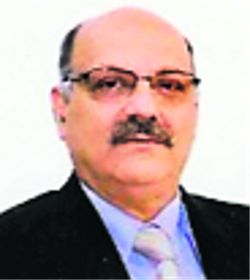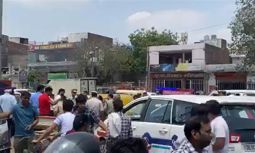
SIGNIFICANT: Iran has made its nuclear ambitions central to its exercise of sovereign exceptionalism with sanctions not deterring modernisation of facilities. Reuters
Lt Gen Sanjiv Langer (retd)
Former Deputy Chief of Defence Staff
IRAN’S nuclear programme lies nestled in an intricate web of strategic possibilities. It is a fine example of how the complexities of the 21st century enable national assertions that are difficult to restrain. It is also instructive to see how its strategic location and domination of the hydrocarbon sea lanes gives Iran a compelling autonomy. As negotiations on the JCPOA (Joint Comprehensive Plan of Action) resume in Vienna on November 29, a view of the considerable implications is apt.
The Iranian programme commenced with the vision of the Shah of Iran, enabled by the US Atoms for Peace programme in March 1967.The US provided a 5-MW research reactor, Iran signed the NPT and was ratified as a member. The Shah unfolded a plan for 23 nuclear power stations by 2000 AD, and the US moved the CENTO, Nuclear Science Institute, to Tehran from Baghdad in 1968. In 1976, the US built a reprocessing facility to extract plutonium, completing the nuclear fuel cycle in Iran.
The Iranian Revolution of 1979 and the rise of Ayatollah Khomeni signalled the abrupt US exit (labelled The Great Satan). The US responded with increasing opposition to the Iranian programme. Several developed nations, however, exploited the vacuum due to its commercial promise and ensured vibrancy of the programme. It was in 1984 (during the Iran-Iraq war) that a West German intelligence report revealed that the Iranians were also pursuing the creation of a nuclear weapon with uranium from Pakistan.
This ushered in an era of enhanced IAEA (International Atomic Energy Agency) scrutiny, together with UN and US restraints and sanctions. The formal IAEA acknowledgements commenced in 2003, when it was reported that Iran had failed to report its enrichment and reprocessing. In 2005, the UN Security Council imposed sanctions, demanding the suspension of enrichment.
Iran, post the Islamic Revolution, has always claimed its inalienable right to a peaceful nuclear programme. Its nuclear weapons’ ambition, however, goes back to the ruminations of the Shah on the balance of power as well as its painful experience of the Iran-Iraq war (1980-88), when it feared a nuclear attack as well as contemplated its use in terminating the war.
Iran developed a geographically distributed location profile for its facilities. While permitting the IAEA regular inspections, suspicions of its core weapons development programme continued. This resulted in a paradigm of sanctions and restrictions on Iran as well as a polarisation of the international community. Benefiting from Russia, and more significantly, China, the Iranian programme, despite the restrictions, raced on.
The US and other UN Permanent Members realised that the economic debilitation of Iran had had a limited effect on its nuclear progress. Resultantly, in July 2015, a Joint Comprehensive Plan of Action was signed between the UN Permanent Members plus Germany (JCPOA P5+1) and Iran. The removal of sanctions was to be reciprocated by an Iranian reduction in stockpiles and no movement towards a weapons programme.
Iran, however, continued with missile development and testing of MRBMs (medium-range ballistic missiles) as well as other eye-catching weapon programmes. Calling the JCPOA as an inadequate mechanism and deeply suspicious of the intentions of Iran, the then US President Trump withdrew from it in May 2018.
The present Vienna initiative is because of President Biden’s commitment to move ahead on the JCPOA and comes on the heels of Iran and US indirect talks.
AQ Khan, with his Pakistan-based proliferation network, reportedly helped Iran in the hope that their bomb would neutralise Israel. The geostrategic realities present the prospect of Saudi Arabia seeking a nuclear weapon if Iran develops one.
Meanwhile, Pakistan and Iran are now bitterly opposed to each other in Afghanistan as well as on issues related to the Shia minority. Pakistan has been an ardent backer of the US sanctions on Iran. China, ignoring the sanctions, has been buying hydrocarbons from Iran, while supporting its nuclear programme. India has close relations with Iran, continues to import its oil and has convergence with Iran related to Afghanistan. Iran also provides a valuable access for India to the Central Asian Republics.
In the nuclear domain, India is crowded in by two unpredictable and obdurate nuclear neighbours. In truth, despite all strategic equations and scenarios, in the nuclear domain between two or more potential adversaries, unintended consequences are critical. A nuclear Iran opposed to Israel and Saudi Arabia (among others), unleashing prospects for a nuclear Saudi Arabia, all in the Indian immediate neighbourhood of consequence, stretches the strategic envelope well beyond what the international community is equipped to deal with. Understandably, the Indian stand has been that Iran adheres to the IAEA regulations and safeguards.
A far more significant observation is how Iran has made its nuclear ambitions central to its exercise of sovereign exceptionalism. The Iranian nuclear facilities and programme have been attacked, commencing from the Stuxnet attack of 2010 that reportedly destroyed many centrifuges to the recent reported sabotage at the Natanz facility in April 2021. There has been a chain of assassinations of nuclear scientists, the latest being Mohsen Fakhrizadeh in 2020.
The Iranian economy has been severely mauled by sanctions and restrictions. Oil and petroleum products that account for 80 per cent of Iranian exports were down to 300,000 barrels per day from a pre-2012 level of 2.1 million barrels a day. None of this deterred the modernisation and production of the total facilities.
With focused determination, Iran has upgraded and modernised its facilities as well as enhanced stockpiles and enrichment. It has assiduously followed a missile development plan. Once the US withdrew from the JCPOA, Iran said it was no longer bound by any restrictions and would progress as it saw best. President Ebrahim Raisi will, undoubtedly, take a hard line in the ensuing Vienna negotiations while the Supreme Leader, Ali Khamenei, has stated that they are in no hurry.
The Chinese and Russian support, undoubtedly, gives Iran great comfort. Iran’s wider arc of influence, enhanced post the Iraq war and the survival of the Assad regime in Syria, is intoxicating. The performance of entities Iran supports such as Hezbollah and the Houthis is gratifying. Adherence to nuclear autonomy, additionally, by Iran as a symbol of national assertion is plainly apparent.
We must accept that force and intimidation, coupled with economic pain, do not prevail on nations that have strategic assets and have chosen a path linked to deeply emotive issues. The present international order of competing power centres, with few convergences, provide willing partners to conscientious dissenters. The negotiations at Vienna are critical for the world and the region. Despite vocal initial positions, the hope is that flexible negotiations will lead to a rapprochement.
Join Whatsapp Channel of The Tribune for latest updates.




























